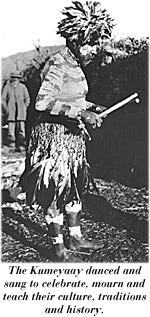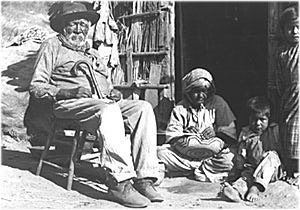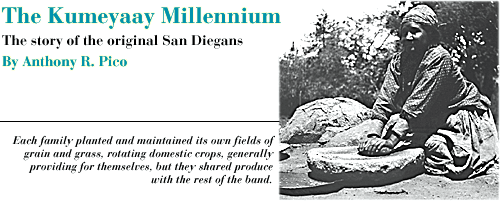|
For 10 millennia
before the Spanish and other European settlers arrived in California,
the Kumeyaay Indian Nation lived in the area now divided into San Diego
and Imperial Counties and Baja Norte. Although this nation of original
inhabitants has been called Southern Diegueño, Diegueño-Kamia,
Ipai-Tipai and Mission Indians, the people prefer to be known as Kumeyaay.
Yuman-speaking people of Hokan stock, Kumeyaay
territory extended from the Pacific Ocean east to the Colorado River,
north to Warner Springs Valley and south to Ensenada. Neighboring nations
to the northeast and east were the San Lusieño, Cupeño
and Cahuilla. While southern California Indian nations shared many characteristics,
there was little uniformity in language, customs, political and social
organization or economic resources.
Indian nations throughout California, and North
and South America were comparable to the multiple cultures, governments,
religions, economic resources and languages of independent nations that
abounded on the European, African and Asian continents in the year 1000
AD.
The Kumeyaay planted trees and fields of grain;
grew squash, beans and corn; gathered and grew medicinal herbs and plants,
and dined on fresh fruits, berries, pine nuts and acorns. Kumeyaay fished,
hunted deer and other animals, and were known for basket weaving and
pottery. The people had sophisticated practices of agriculture, plant
and animal husbandry; maintained wild animal stocks; controlled erosion
and overgrowth; built dams; created watersheds and stored groundwater.
 A federation
of autono-mous, self-governing bands, or clans, the Kumeyaay had clearly
defined territories that included individual and collectively owned
properties. The Kumeyaay united in defense of their territory and communicated
by foot couriers. Throughout this vast area trails were forged by the
Kumeyaay through the mountains, deserts and river valleys for trading,
gathering for funerals, marriages and competitive games with each other
and neighboring nations. A federation
of autono-mous, self-governing bands, or clans, the Kumeyaay had clearly
defined territories that included individual and collectively owned
properties. The Kumeyaay united in defense of their territory and communicated
by foot couriers. Throughout this vast area trails were forged by the
Kumeyaay through the mountains, deserts and river valleys for trading,
gathering for funerals, marriages and competitive games with each other
and neighboring nations.
A band's territory extended anywhere from 10
to 30 miles, along a stream and tributaries. It included trails, shared
hunting, religious, ceremonial and common gathering areas. However,
specific land tenured by families and individuals provided the economic
foundation of the Kumeyaay existence. Property was generally passed
from father to son.
Each family independently planted and maintained
fields of grain, grass and other annuals, shrubs, tree groves, cornfields,
quarries and hot and cold springs, clay beds and basket grass clumps.
However, sharing the produce for the band's benefit was assumed. Territory
belonging to a band often included adjacent holdings stretching from
the mountains and river plains, to the coast.
The Kumeyaay took advantage of the different
climatic zones in the region, surviving fluctuations in the climate
by rotating domestic crops and living off varieties of food sources
in the different ecological systems.
Sacred lands were shared. Creation stories and
religious rituals were tied to specific locations, or holy lands, just
as with the Hebrews, Christians and Muslims. One such place is Kuuchamaa,
or Tecate Peak. Another is Wee-ishpa, or Signal Mountain. Burial grounds
were sacred, and still are to this day. Each band had worship areas
restricted to religious and tribal leaders.
Generally peaceful by nature, the Kumeyaay social
and governmental customs of tolerance and individual freedom spawned
independent people.
The social structure of the bands included the
shiimull, or ancestral descent group, governed by a hierarchy of kwaaypaays.
The shiimull often had family loyalties and relatives that extended
beyond the band through marriage. In 1769, when the Spanish arrived,
between 50 and 75 shiimull, or bands existed. Each included 5 to 15
family groups.
The kwaaypaay was usually the male head of a
shiimull. He inherited the position from his father, but was not necessarily
from the band he led. The kwaaypaays were raised to become leaders.
A common practice was for the kwaaypaay of one band to be selected from
another band, thus ensuring unity among the clans. Also, since the primary
duty was to maintain harmony and arbitrate disputes, a kwaaypaay without
relatives in the band to prejudice decisions was more impartial and
fair. Even though the leadership was drawn from among the sons of all
kwaaypaays, the final choice, and approval of their leader, belonged
to the band.
Each kwaaypaay, or captain or chief, as they
came to be called, had an assistant called the speaker, and a council
of kuseyaay. Composed of male and female priests, scientists, doctors
and other specialists, kuseyaays served as advisers in ecology, resource
management, healing, and the spiritual and religious practices of the
tribe.
The kwaaypaay called upon these counselors to
assist in providing information and making decisions for the tribe's
welfare. Once a decision was made, it had the force of law.
However, each family was free to follow and
participate in the decision, or break off from the band; leave the band's
territory and pursue its own course of action without punishment or
retribution.
The Kumeyaay lived life through songs. They
danced and sang to celebrate, mourn and teach. Culture, traditions,
history and social values were transmitted through songs. Songs taught
everything the people needed to know to survive. There were songs about
the environment such as salt, wildcats and plants. There was no written
language. Songs contained the collective wisdom and memories of the
Kumeyaay people.
Individuals and clans had songs. Spiritual and
creation songs and dances, such as the Bird Song and Eagle Dance, taught
moral lessons and connected people with the ancestors and the meaning
of life and death.
In 1542, life began to change for the Kumeyaay.
No longer a story of a culture and people evolving, living, dying, shaping
and being shaped by the environment, it was a time of death caused by
hunger and disease, occupation, slavery, rape and genocide.
The last 500 years of the millennium for the
Kumeyaay was a time of survival and conquest. The shared history became
a story of clashing cultures and the struggle of the Kumeyaay to adapt,
yet maintain their cultural identity in a changed world.
First came the Spanish, followed by the Mexican
government and the United States. Each believed the land and people
who had lived here for millennia existed for their use and abuse.
Unable to provide protection from the influx
and military might of the newcomers, removed from food sources and land,
unable to speak the language or understand the customs of the immigrants,
and without legal protection of civil rights, the Kumeyaay became totally
dependent upon a hostile populace, strangers in their own land. Denied
customs, culture, social and political traditions, the Kumeyaay became
strangers to themselves.
Despite common beliefs that Californian Indians,
beleaguered of soul and body, crept away to die, these ancestors survived.
Their story of sacrifice and courage and belief that the Kumeyaay would
reclaim a place in this land is as positive and encouraging as their
suffering was devastating.

Generally peaceful by nature, a Kumeyaay band would include
as many as 15 family groups.
|
1769-1822 The Mission Period
In September 1542, the coastal Kumeyaay encountered
the first European, Juan Rodriquez Cabrillo, when his ship sailed into
San Diego Bay.
Then, in 1769, the Spanish sent a colonizing
force into upper California.
Spanish army units founded a presidio (army
post) in San Diego Bay and Franciscan Juan Crespi arrived with the first
overland group of Spanish missionaries and soldiers. He was followed
in July by Father Junipero Serra, with a group led by Gaspar de Portola.
Father Serra, founder of the Mission San Diego, and others like him
were charged with bringing the natives to Catholic Christianity. Thus
began the mission years for the Kumeyaay.
The directive of the priests was to educate
the natives in "civilized pursuits and to make them working class citizens
of the Spanish Empire." Once converted and properly indoctrinated in
the customs of the church and the realm, these baptized Indians would
be granted a piece of land. The local missions also were expected to
supply the army with food, livestock and laborers for mission pueblos
and private ranch holdings granted by the Spanish government.
Kumeyaay coastal land was confiscated and the
people captured and forced to work for the Spanish. Soldiers scoured
the countryside for Indians to be rounded up for conversion and indentured
slave labor. After a period of indoctrination and servitude, some were
released to return to their homes. The women were often raped and used
as property of the militia. Unmarried Indian girls, the sick, some elderly
and men trained as specialists in leather and woodworking, carpenters,
farmers and blacksmiths were permanently kept at the mission, often
against their will.
To avoid capture the Kumeyaay fled east to the
mountains to make new homes. Kumeyaay ritual and spiritual practices
were outlawed. The Kumeyaay revolted against forced servitude and abduction.
In 1776, there were a number of uprisings and skirmishes, one destroying
the San Diego Mission, which was rebuilt on another location. The Spanish
forces moved inland, taking Kumeyaay lands in Santee, El Cajon, Jamacha
and Jamul to gain control of better water resources.
Death stalked the Kumeyaay in many ways. Without
natural immunities the Kumeyaay, exposed to European diseases, died
by the thousands as smallpox and measles spread through the villages.
1822-1848 Mexican Period
Following the Mexican Revolution and founding
of the Republic of Mexico in 1822, the Spanish holdings were secularized.
During the Mexican period, the missions became parish churches and mission
lands, rancheros. Prior commitments made to Hispanicized Kumeyaay for
small plots of land by the Spanish were dismissed. Mexican governors
gave the best mission lands to Mexican nationals, and conceded large
land grants, absorbing farms of Hispaniized Indians granted by the Spanish,
as well as Kumeyaay villages within their boundaries.
Kumeyaay living on former mission properties
were turned over to Mexican nationals to serve as peon labor. Missions
were placed under majordomos, who used the Indians as servants for their
large families. Majordomos allocated passes to the Kumeyaay laborers
to leave the rancheros to visit their families, and sent patrols to
recapture those who did not return. The Kumeyaay became prisoners on
their own land, trading one form of enslavement for another.
When repeated requests to the Mexican government
by the Kumeyaay about abuses of their land and water rights were ignored,
inland bands led numerous uprisings and revolts. In San Diego, Mexicans
seldom left the presidio or pueblos without military guard.
Eventually, the United States moved to acquire
the California territories. In December 1846, the U.S. Army led by Gen.
Stephen Watts Kearny passed through Yuma, San Felipe, Warners Valley,
Santa Ysabel and San Pasqual, destroying Kumeyaay homes for firewood.
The Kumeyaay and other Indians were friendly
toward the Americans, hopeful that this new government would keep promises
to settle the land disputes and treat the Indians fairly. During the
battle of San Pasqual between the Mexicans and U.S. Army, the Kumeyaay
aided General Kearny. After the battle, they guided him to San Diego.
The 1848 Treaty of Guadalupe Hidalgo transferred
California to the United States and guaranteed existing land titles,
all rights and immunities, and religious freedom to Mexican citizens.
All these rights also were to be applied to baptized Indians who became
Mexican citizens; however they were rarely enforced for the Christian
Kumeyaays, and never for the traditional Kumeyaays.
Anthony R. Pico is tribal chairman of the Viejas Bank
of Kumeyaay Indians.
Click here for Part
2
|

 A federation
of autono-mous, self-governing bands, or clans, the Kumeyaay had clearly
defined territories that included individual and collectively owned
properties. The Kumeyaay united in defense of their territory and communicated
by foot couriers. Throughout this vast area trails were forged by the
Kumeyaay through the mountains, deserts and river valleys for trading,
gathering for funerals, marriages and competitive games with each other
and neighboring nations.
A federation
of autono-mous, self-governing bands, or clans, the Kumeyaay had clearly
defined territories that included individual and collectively owned
properties. The Kumeyaay united in defense of their territory and communicated
by foot couriers. Throughout this vast area trails were forged by the
Kumeyaay through the mountains, deserts and river valleys for trading,
gathering for funerals, marriages and competitive games with each other
and neighboring nations.